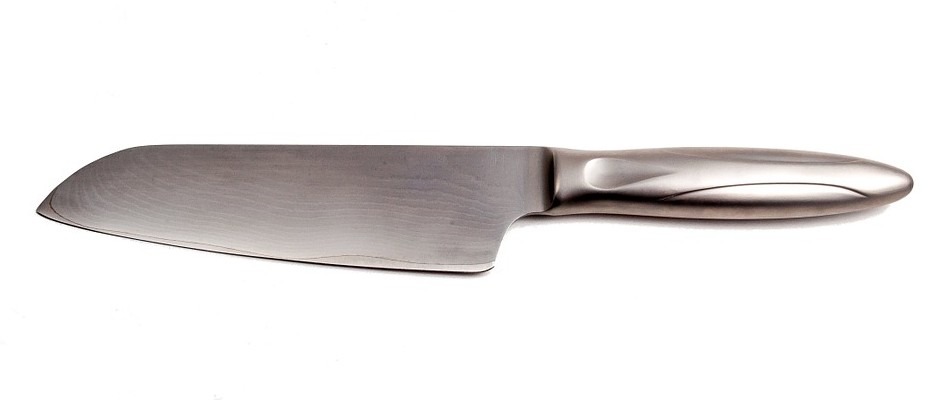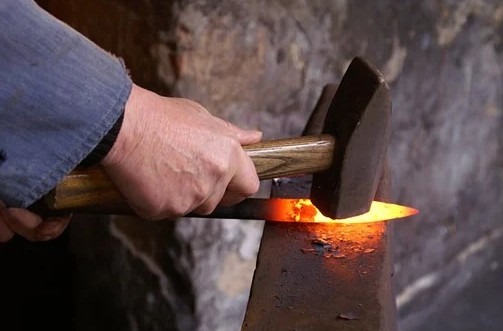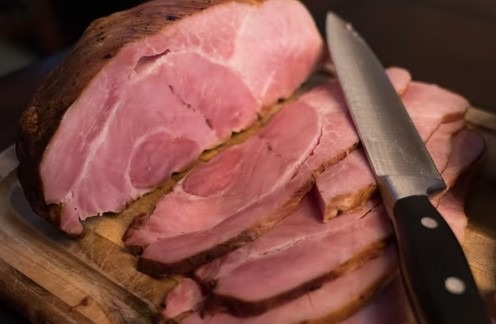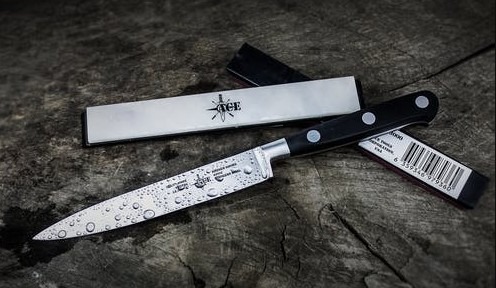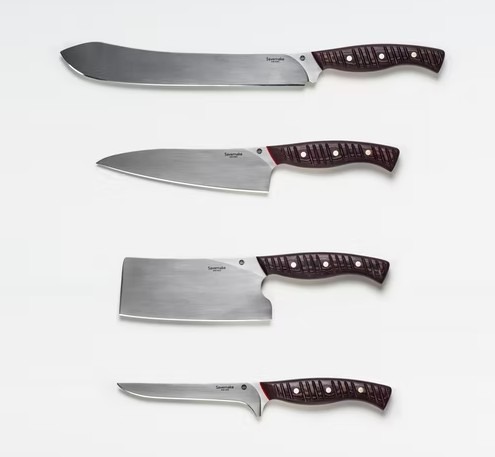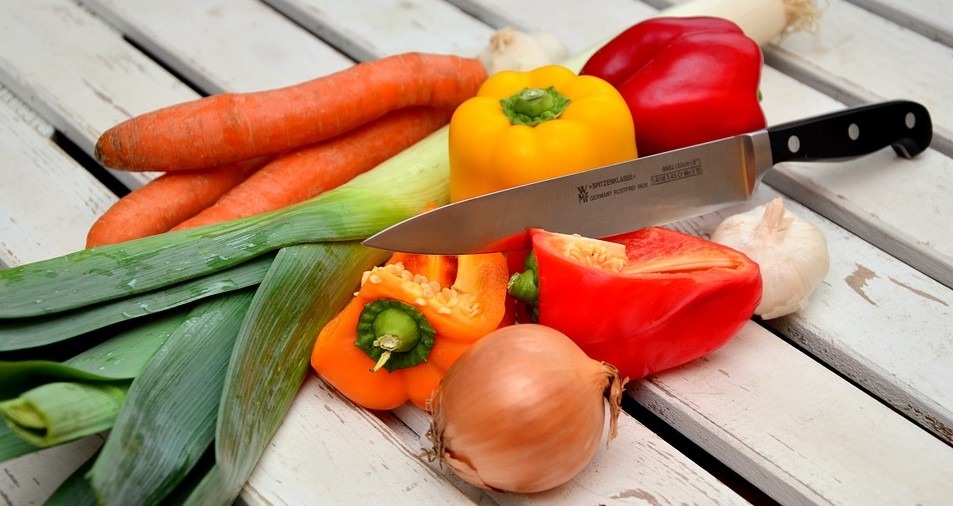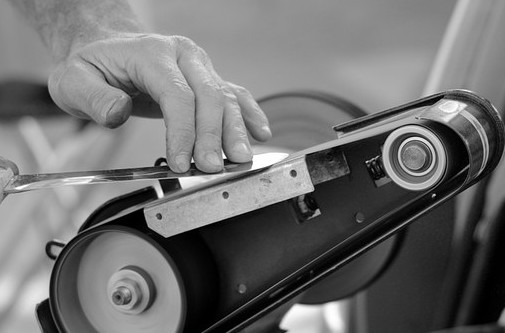Knife forging involves hammering and heating a knife from a single steel rod. Forging strengthens the steel. The formation of steel molecules during the forging process results in a less flexible sheet. As a result, these knives stay sharp longer. Also, these knives are more comfortable and balanced due to the existence of reinforcement that comes from the bolster or the forging process.
A forged knife comes from a single bar of steel. It goes from this bar to a beautifully crafted forge knife in an intensive process. Also, it requires skilled craftsmen and knowledge to make a forged knife. The characteristics of a forged knife make it better than a stamped knife up to some extent. They have a significant impact on the thickness, edge retention, weight, sharpness, and more.
What Are Forged Knives?
Forged knives are usually thicker and heavier than the stamped kitchen and cooking knives. Most of them are reinforced during the manufacturing process. Hence, the design adds a natural weight to the forged knives. Forged knives are preferred by chefs due to the power and weight that give them a sturdy and firm feel during heavy cuts.
The weight, on other hand, gives a balance to the cutting surface. It makes forged knives perfect for chipping jobs. Due to the rigid and strong structure, they give a precise cutting of hard things such as pumpkin. It is because the forged knives are less likely to bend.
Additionally, forged knives have gussets which add an extra layer of protection for the fingers. They work as a natural stop for movements.
Manufacturing Process
Some small kitchen knife makers make hand-forged knives. Due to high demand, it has forced large companies to increase their production. For this purpose, a combination of practical influence and robotic technology is essential.
The basic steps of the forging process include:
- Computer-Aided Design for knife mold.
- Pre-cut steel bars heated to extremely high temperatures.
- Squeeze the red heated steel into the shape.
- Tempering of knife steel sheets to adjust the hardness.
- Crushed to give edges to the knife.
- Cleaning, polishing, and inspecting carefully.
- Handle accessory, as well as finish for the tang and bolster.
- Sharpening to a preset angle and final inspection.
The forged knives are more expensive than the stamped knives because of the extensive and laborious process. Also, it requires a combination of technology and skilled labor. Some respected brands in the knife-making industry follow a 40-step process. In these steps, there are various quality checks to ensure the best quality of forged knives.
There was a time when the forged knives were mostly hand forged. The forging process requires heating of furnaces to at least 2000°F. It helps to make the shape of a metal alloy into a forged knife. On the other hand, modern forging requires robotics and special equipment throughout the process.
Apart from the use of machines and labor, some brands still use hot-drop forging. In this process, the red-hot metal is shaped into a forged knife by swinging the hammer on it. The quality of the forging knives does not depend on the modern or traditional process, but exceptionally, forged knives are durable and stronger than stamped knives.
Pros of Forged Knives
- The full tang design distributes the weight and is balanced properly.
- The blade does not bend or wrap when cutting through hard surfaces.
- The heavier weight gives you more power and weight behind each cut.
- The forging process gives you a high-quality forged knife.
- Forged knives are stable because of bolsters.
Cons of Forged Knives
- Forged knives are more expensive than stamped knives.
- The additional weight because of the bolster or full tang can be fatigued for prolonged use.
- Less flexible blades make it difficult for delicate tasks in the kitchen such as boning poultry or fish filleting.
Characteristics of Forged Knife
| Manufacturing Process | Tempered and Heat Moulded |
| Blade Thickness | Thicker Profile |
| Bolster | Yes, Half or Full Bolster |
| Tang | Full-Tang, Half-Tang or Partial Tang |
| Weight | Heavy |
| Blade Flexibility | Rigid |
| Sharpness | Very Sharp |
| Edge Retention | Holds Edge Well |
| Ease of Sharpening | Easier |
| Price | $$$$ |
Blade Thickness
The blades of the forged knives are thicker than stamped ones. It is because they start with a metal alloy block. The thickness of the blade in forged knives can vary from front to rear. Usually, the blades are thicker along the column and thinner towards the tip. Additionally, the thickest part of the forged knife is the handle. It goes thicker from the rear end to the bolster.
The thickness of a forged blade does not only make it durable but also stable. When it is combined with the weight, it makes a perfect fit for cutting meats and thick vegetables or fruits.
Bolster
A thick metal piece resting between the handle and the blade is, bolster. Unlike stamped knives, forged ones come with a bolster. Some forged knives come with a half or full bolster. The purpose of the bolster is to prevent the finger from slipping through a finger guard. Also, it strengthens the knife.
Most high-quality forged knives have various types of bolsters. The main ones are:
- Semi-Bolster
- Half Bolster
- Full Bolster
The full bolsters are longer and thicker to provide additional protection. In some forged knives, such bolsters can take away some of the advantages of cutting edge. Some major kitchen knife brands produce full bolster forged knives which make it difficult to sharpen the entire edge. It is because the steel is too thick at the heel.
Semi or half bolsters might not provide the full protection to your fingers but forged knives with such bolsters are easy to sharpen the entire edge.
Tang
Tang, one of the different parts of the knife, is the part of the blade extending to the handle. If the blade extends through the rear end, it is known as full tang. Half or partial tang, on the other hand, goes only halfway or through the handle. Forged knives usually come with full tang making them strong and balanced.
The purpose of the tang is to make it difficult for the handle and blade to separate. It is a built-in safety feature in forged knives. Also, a forged knife with full tang increases the weight making them cumbersome after prolonged use. As a result, some chefs move to stamped knives after getting aching hands.
Weight
The weight of the forged knife comes from the blade thickness, handle material, tang style, and bolster. Also, the heavyweight makes you feel that the knife has more substance while balanced in the hand. It helps to improve the control and with less effort, you can cut more. On the other hand, the heavyweight of forged knives can give you a hand ache or fatigue after prolonged use.
Hence, the heavyweight of the forged knife makes it perfect for cutting thick foods like pineapple or spaghetti squash.
Blade Flexibility
The blades of the forged knives are more rigid than the stamped knives. They are perfect for cutting vegetables and fruits, herbs, meat, or any other stiff thing. As a result, a rigid blade gives you a controllable knife. If you are sharpening the blade with a whetstone, then you don’t have to worry about it because stiffer blades sharpen easily.
Sharpness
The forged and stamped knives have sharp edges out of the box. The sharpness of the knife depends on the edge angle per side. It can vary from 10 to 20 degrees but with 15 degrees per side, the sharpness and durability are outstanding.
The forged knives are suitable for intensive slicing and chopping with rolling and pushing movements. The edges of the forged knives act as a wedge as the blade thickens while the edge cuts. As a result, the food slides up.
Edge Retention
Generally, forged knives can hold their cutting edges for a longer period than stamped knives. As a result, you don’t have to sharpen the forged knife more often. In the forging process, the extreme heat and tempering give a rigid and hard blade. The harder the blade, the longer the retention. Hence, they have better edge retention than the softer or flexible blades.
Ease of Sharpening
There are various ways of keeping your knives sharpened. For example, manual sharpening requires a stiff or rigid blade. As forged knives come with a rigid blade, they can easily be sharpened with manual methods. On the other hand, if you are using an electric knife sharpener, then you can easily sharpen a forged or stamped knife.
Forged Knives – Rigid and Heavyweight Knives
Forged knives are manufactured through a combination of practical influence and robotic technology. Also, the forging process requires intensive labor work resulting in expensive forged knives. This is why forged knives are more expensive than stamped knives. The forged knives come with a rigid blade and heavyweight which gives a precise cut with less effort.
A rigid blade, on the other hand, improves the edge retention and ease of sharpening. The rigid blade enhances the edges of the forged knives, which means the edges do not wear out quickly. As a result, you don’t have to sharpen the forged knives more often. Talking about the built-in safety feature in the forged knives is full, half, or semi-bolster. It prevents slipping and guards the finger.


